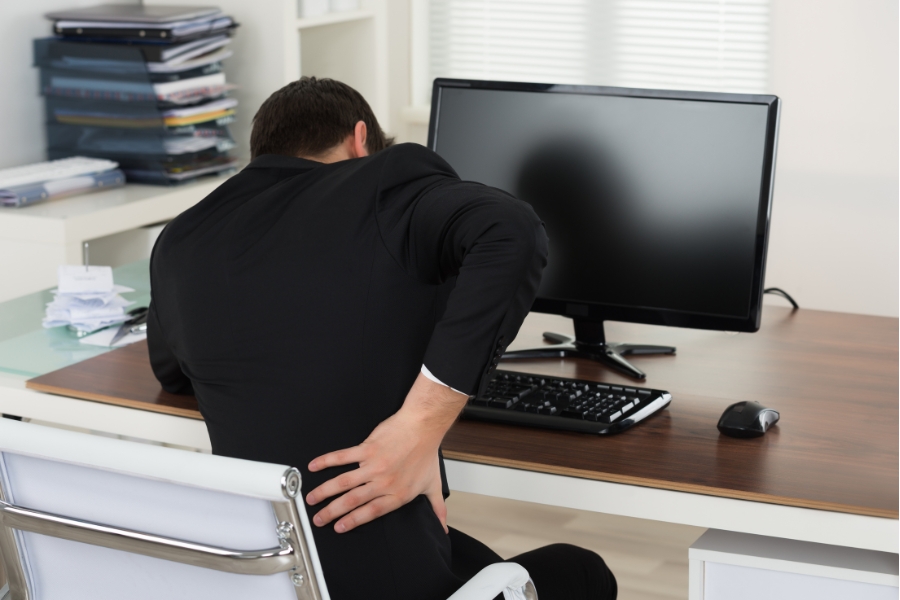
Ways to Avoid Back Pain When Sitting All Day
Sitting for extended periods has become an integral part of modern life, particularly for those of us who work office jobs. But with this sedentary lifestyle comes the risk of developing back pain, a common complaint among desk-bound professionals. In this article, I’ll explore 10 effective strategies to protect your back from the negative effects of sitting all day. From maintaining good posture to knowing when it’s time to consult a doctor, these tips will help you stay comfortable and healthy even with a desk job.
Table of Contents
ToggleBenefits and importance of maintaining good posture to avoid back pain when sitting all day
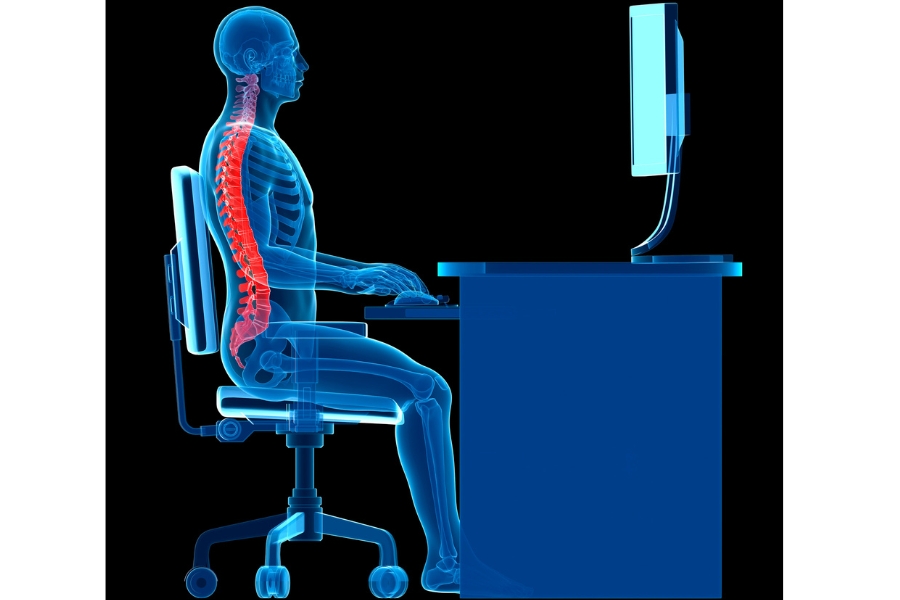
Benefits and importance of maintaining good posture to avoid back pain when sitting all day
Maintaining good posture isn’t just about looking poised; it’s a crucial aspect of preventing back pain. When I sit, I make a conscious effort to align my ears, shoulders, and hips in a straight line. This simple adjustment helps distribute my weight evenly and reduces strain on my back muscles.
At first, holding this position required a constant reminder. To make it a habit, I placed a sticky note on my monitor that read “Sit Up Straight!” It served as an effective visual cue to correct my posture throughout the day. Another strategy that worked for me was setting a timer to go off every hour as a prompt to check and adjust my posture.
A well-aligned posture not only minimizes the risk of discomfort but can also improve breathing and digestion. Over time, I found that maintaining good posture became second nature, and the benefits extended beyond just alleviating back pain; I felt more focused and energetic as well.
Sitting all day can take a toll on your back, but maintaining good posture can help prevent pain and discomfort. Here are some of the benefits and importance of maintaining good posture:
- Reduced back pain: When you slouch, you put extra strain on your back muscles and ligaments. Over time, this can lead to pain and stiffness. Good posture helps to distribute your weight evenly and takes pressure off your spine.
- Improved circulation: Slouching can compress your blood vessels, which can restrict blood flow. This can lead to fatigue, pain, and even numbness in your legs and feet. Good posture helps to improve circulation throughout your body.
- Increased lung capacity: When you slouch, your chest is compressed, which can make it difficult to take deep breaths. Good posture allows your lungs to expand fully, which can improve your breathing and increase your oxygen intake.
- Enhanced mood and confidence: Good posture has been shown to improve mood and confidence. This may be because good posture makes you feel more powerful and in control.
Here are some tips for maintaining good posture while sitting:
- Sit up straight with your shoulders relaxed and back against the chair.
- Keep your feet flat on the floor and your knees bent at a 90-degree angle.
- Make sure your chair is at the right height so that your thighs are parallel to the floor.
- Use a lumbar support pillow to help maintain the natural curve of your spine.
- Get up and move around every 30 minutes or so to avoid stiffness.
By following these tips, you can help to maintain good posture and avoid back pain when sitting all day.
Benefits and importance of getting up and moving around every 30 minutes to avoid back pain from sitting all day

Benefits and importance of getting up and moving around every 30 minutes to avoid back pain from sitting all day
To counteract the negative effects of sitting, I’ve adopted the habit of standing up and moving around every 30 minutes. Research suggests that short, frequent breaks to stand and stretch can significantly reduce back pain associated with prolonged sitting. This practice increases blood flow, rehydrates spinal discs, and helps maintain muscle flexibility.
Incorporating these breaks into my routine was challenging at first. However, I started using a desktop application that reminds me to take a walk or do a quick stretch every half hour. These breaks have become moments that I look forward to, as they not only rejuvenate my back but also clear my mind and boost my productivity.
During these breaks, I avoid simply standing up and then sitting back down. Instead, I take a brisk walk, do some light stretching, or even perform a few squats. This variety of movements ensures that different muscle groups are activated and prevents any one area from becoming overstrained.
Sitting for long periods, especially with poor posture, can put a strain on your back muscles and lead to pain and stiffness. Getting up and moving around every 30 minutes can help to:
- Improve blood flow: Sitting for long periods can restrict blood flow to your legs and buttocks, which can contribute to pain and discomfort. Getting up and moving around helps to improve circulation and reduce this risk.
- Reduce muscle tension: Sitting in the same position for too long can cause your back muscles to become tense and tight. Getting up and moving around helps to stretch and loosen these muscles, reducing tension and pain.
- Strengthen core muscles: A strong core is essential for good posture and back health. Getting up and moving around throughout the day helps to engage your core muscles and keep them strong.
- Boost mental alertness: Sitting for long periods can make you feel sluggish and tired. Getting up and moving around helps to increase blood flow to the brain, which can improve your focus and concentration.
Here are some tips for getting up and moving around every 30 minutes:
- Set a timer on your phone or computer to remind you to get up and move around.
- Take a short walk around the office or outside.
- Do some stretches or light exercises, such as arm circles, toe touches, or squats.
- Get a drink of water or use the restroom.
Even short bursts of activity can make a big difference in your overall health and well-being. So next time you’re sitting for a long period, make sure to get up and move around every 30 minutes.
Benefits and importance of using an ergonomic chair to avoid back pain when sitting all day
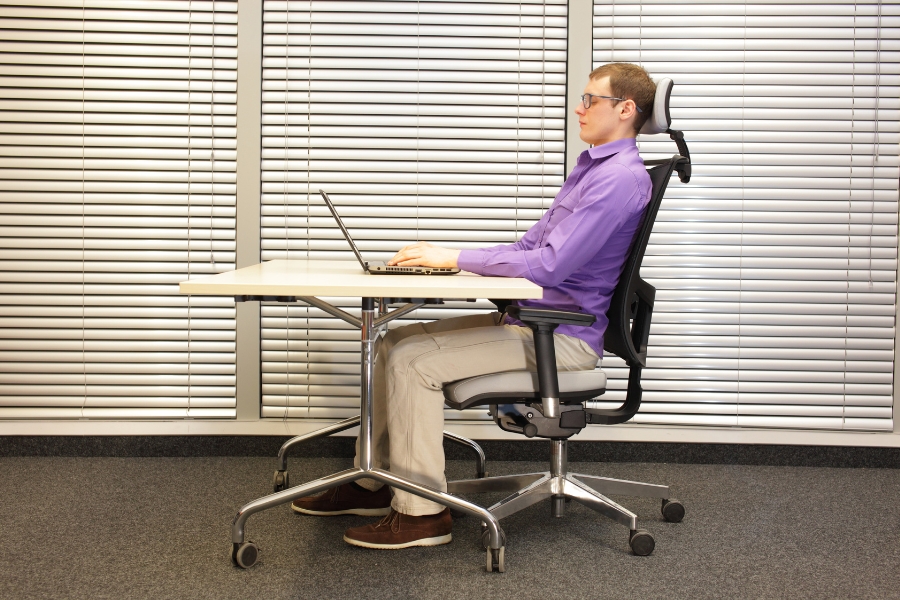
Benefits and importance of using an ergonomic chair to avoid back pain when sitting all day
Use an Ergonomic work chair: Investing in an ergonomic chair was one of the best decisions I made for my back health. An ergonomic chair provides proper lumbar support, which helps maintain the natural curve of the lower spine. The adjustability of the seat height, backrest, and armrests ensures that I can tailor the chair to my body’s specific needs.
when choosing an Ergonomic chair, I considered several factors, such as the depth of the seat pan, the firmness of the cushioning, and the responsiveness of the backrest. It was important for me to choose a chair that felt comfortable immediately but also provided support during long hours of work.
The right chair can make a significant difference in how my back feels at the end of the day. With an ergonomic chair, I’ve noticed a marked reduction in the tension and soreness that used to plague me after a day at my desk. It’s a worthwhile investment for anyone who spends a lot of time sitting.
Sitting for long periods, especially with poor posture, can lead to a number of problems, including back pain, neck pain, and even carpal tunnel syndrome. Ergonomic chairs are designed to help prevent these problems by providing proper support for your body.
Benefits of using an ergonomic chair:
- Improved posture: Ergonomic chairs are designed to encourage good posture by providing lumbar support, adjustable armrests, and a headrest. This can help to reduce strain on your back, neck, and shoulders.
- Reduced pain: By supporting your body in a proper position, ergonomic chairs can help to reduce pain in your back, neck, and shoulders.
- Increased comfort: Ergonomic chairs are often more comfortable than traditional chairs, which can help you to stay focused and productive throughout the day.
- Improved circulation: Ergonomic chairs can help to improve circulation in your legs by keeping them at a proper angle.
- Reduced risk of injuries: By promoting good posture and reducing strain on your body, ergonomic chairs can help to reduce your risk of injuries from sitting for long periods.
Importance of using an ergonomic chair:
If you sit for long periods of time, it is important to use an ergonomic chair to help prevent pain and injuries. Ergonomic chairs can also help to improve your comfort, focus, and productivity.
Here are some additional tips for preventing back pain when sitting all day:
- Take breaks every 30 minutes to get up and move around.
- Stretch regularly throughout the day.
- Make sure your chair is adjusted to the proper height and depth.
- Use a footrest if you need one.
Benefits and importance of regular Stretching to avoid back pain from sitting all day

Benefits and importance of regular Stretching to avoid back pain from sitting all day
Stretch regularly: Stretching exercises are essential for relieving tension and improving flexibility in the back. Throughout my day, I incorporate a series of stretches that target the back, shoulders, and neck. These exercises can be done right at my desk and take only a few minutes.
One of my go-to stretches is the seated spinal twist. I sit up straight, place one hand on the opposite knee, and gently twist my torso while looking over my shoulder. This stretch helps loosen tight muscles and realigns my spine after hours of sitting.
Another effective stretch is the forward fold. Standing with my feet shoulder-width apart, I hinge at the hips and reach toward the ground. This elongates the spine and relieves pressure on the lower back. I hold each stretch for 15 to 30 seconds, breathing deeply to maximize the tension release.
Benefits of regular stretching:
- Improved flexibility: Stretching helps to lengthen your muscles, which can improve your range of motion and make it easier to move around. This is especially important for people who sit at a desk all day, as they can become very stiff and inflexible.
- Reduced pain: Stretching can help to relieve pain from tight muscles and improve blood circulation, which can help to reduce inflammation.
- Improved posture: Stretching can help to improve your posture by lengthening the tight muscles that pull you out of alignment. This can help to reduce pain and discomfort in your back, neck, and shoulders.
- Reduced risk of injury: Stretching can help to prevent injuries by keeping your muscles loose and flexible. This is important for people who are active, as well as for people who sit at a desk all day, as they can be at risk for repetitive strain injuries.
Here are some specific stretches that can help to prevent back pain from sitting all day:
- Neck stretches: Gently roll your head in a circle, first in one direction and then in the other. Then, tilt your head to one side, bringing your ear down towards your shoulder. Hold for 30 seconds and repeat on the other side.
- Shoulder stretches: Roll your shoulders forward and backward in a circular motion. Then, reach one arm overhead and gently pull your elbow down behind your back with the other hand. Hold for 30 seconds and repeat on the other side.
- Chest stretches: Stand in a doorway and place your forearms on either side of the doorframe. Lean forward gently until you feel a stretch in your chest. Hold for 30 seconds.
- Hamstring stretches: Sit on the floor with your legs extended in front of you. Reach forward and try to touch your toes. If you can’t reach your toes, hold onto a strap or towel. Hold for 30 seconds.
- Lower back stretches: Lie on your back with your knees bent and feet flat on the floor. Gently pull one knee to your chest at a time. Hold for 30 seconds on each side.
It is important to stretch regularly, ideally every day. Even a few minutes of stretching can make a big difference. If you are experiencing back pain, it is important to see a doctor to rule out any underlying medical conditions.
Benefits and importance of Strengthening your core muscles to avoid back pain when sitting all day
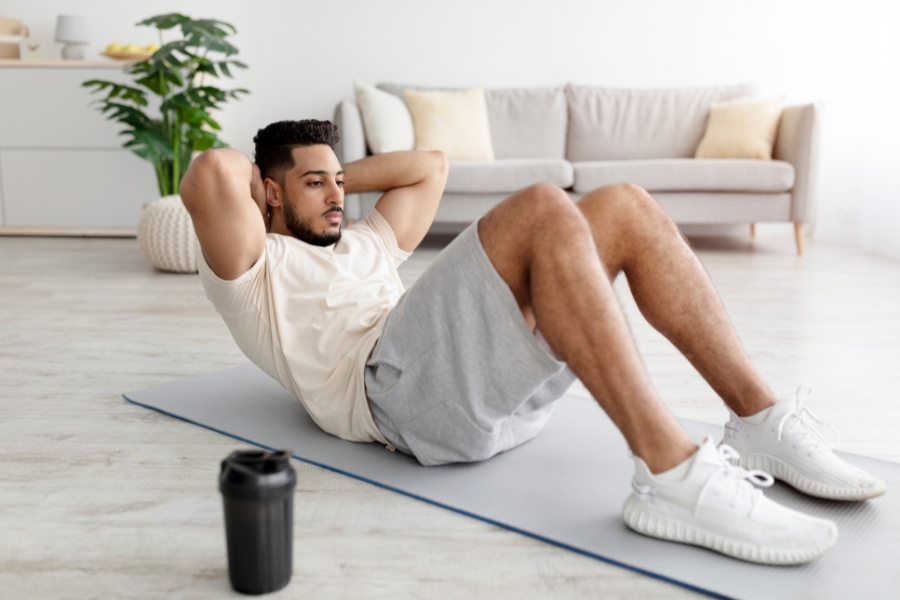
Benefits and importance of Strengthening your core muscles to avoid back pain when sitting all day
Strengthen your core muscles: A strong core is fundamental to supporting the spine and preventing back pain. I’ve incorporated core-strengthening exercises into my fitness routine to build the muscles of my abdomen, back, and pelvis. These exercises have improved my posture and reduced the strain on my back while sitting.
Planks are a simple yet effective exercise for building core strength. I make sure to keep my body in a straight line from head to heels and to engage my abdominal muscles to support my spine. I aim for three sets of 30-second holds, gradually increasing the duration as my strength improves.
Another core exercise I find beneficial is the bridge. Lying on my back with my knees bent, I lift my hips off the ground, creating a straight line from my shoulders to my knees. This not only strengthens the core but also targets the glutes and hamstrings, which play a role in supporting the lower back.
Sitting for extended periods can lead to various health problems, including back pain. This is because prolonged sitting puts a strain on your back muscles, leading to fatigue and discomfort. Strengthening your core muscles can significantly help in preventing and alleviating back pain caused by sitting all day.
Here’s how:
1. Improved posture: Strong core muscles help maintain proper spinal alignment, which is crucial for good posture. Good posture reduces stress on the spine and prevents slouching, which can contribute to back pain.
2. Increased stability: Core muscles act like a natural corset, supporting your spine and pelvis. Stronger core muscles improve your overall stability, making it easier to maintain good posture while sitting and reducing the risk of slouching or twisting, which can strain your back.
3. Reduced stress on the spine: When your core muscles are weak, your spine takes on more stress, leading to pain and fatigue. Strengthening your core helps distribute the load more evenly, taking pressure off your spine and reducing the risk of pain.
4. Enhanced movement mechanics: Strong core muscles improve your body’s ability to transfer force and energy efficiently. This is especially important when lifting objects or performing other activities that require proper form. Stronger core muscles help you move with better control and coordination, reducing the risk of injuries that can lead to back pain.
5. Improved balance: Core strength plays a vital role in maintaining balance. This is important for everyday activities like walking, climbing stairs, and even standing for long periods. Stronger core muscles can help prevent falls, which can cause serious back injuries.
Here are some exercises you can do to strengthen your core muscles:
- Plank: This exercise works multiple core muscles, including your abdominals, obliques, and lower back. Start in a push-up position, but rest on your forearms instead of your hands. Keep your back straight and core engaged, and hold the position for as long as you can comfortably.
- Bird-dog: This exercise strengthens your core and improves stability. Start on all fours, with your hands directly under your shoulders and knees directly under your hips. Extend one arm and the opposite leg out straight, keeping your back flat and core engaged. Hold for a few seconds, then switch sides.
- Dead bug: This exercise targets your deep core muscles. Lie on your back with your knees bent and feet flat on the floor. Raise one leg and extend your opposite arm straight out overhead. Keep your lower back pressed into the floor and your core engaged. Lower your leg and arm back down, then repeat on the other side.
Remember, before starting any new exercise program, it’s essential to consult with a healthcare professional, especially if you have any existing back problems. They can help you create a safe and effective exercise plan to strengthen your core and prevent back pain.
Benefits and importance of taking breaks to stand up and move around to avoid back pain from sitting all day

Benefits and importance of taking breaks to stand up and move around to avoid back pain from sitting all day
Take breaks to get up and move around: Regular breaks are not just an opportunity to stretch but also a chance to prevent back pain before it starts. I’ve made it a habit to step away from my desk every hour or so to take a short walk or do some light exercises. These breaks help me avoid the stiffness and discomfort that come from sitting too long.
During these breaks, I focus on activities that engage different muscle groups and promote circulation. Sometimes I’ll take a walk outside, which has the added benefit of fresh air and a change of scenery. Other times, I’ll do a quick circuit of bodyweight exercises like lunges or push-ups.
The key to making these breaks effective is consistency. It can be easy to get absorbed in work and forget to move, so I use reminders on my phone or computer to prompt me. Over time, these breaks have become a natural part of my daily routine and a cornerstone of my strategy to prevent back pain.
Benefits of standing up and moving around:
- Reduces back pain: Sitting for long periods compresses the discs in your spine, which can lead to pain. Standing up and moving around helps to take the pressure off of your discs and allows them to rehydrate.
- Improves circulation: Sitting for long periods can slow down your circulation, which can lead to swelling in your legs and feet. Standing up and moving around helps to improve circulation and reduce swelling.
- Boosts energy levels: Sitting for long periods can make you feel tired and sluggish. Standing up and moving around helps to increase your heart rate and blood flow, which can give you a boost of energy.
- Improves focus: Sitting for long periods can make it difficult to concentrate. Taking breaks to stand up and move around can help to improve your focus and attention span.
- Reduces the risk of chronic diseases: Sitting for long periods has been linked to an increased risk of chronic diseases such as heart disease, diabetes, and obesity. Taking breaks to stand up and move around can help to reduce your risk of developing these diseases.
Importance of taking breaks:
It is important to take breaks to stand up and move around every 30-60 minutes, even if you don’t feel any pain. You can set a timer on your phone or computer to remind yourself to take breaks. There are also a number of ways to incorporate more movement into your workday, such as:
- Taking the stairs instead of the elevator
- Walking to a colleague’s desk instead of emailing them
- Doing some stretches or light exercises at your desk
Taking breaks to stand up and move around is a simple and effective way to help prevent back pain and improve your overall health.
Benefits and importance of Adjusting your workstation to avoid back pain from sitting all day
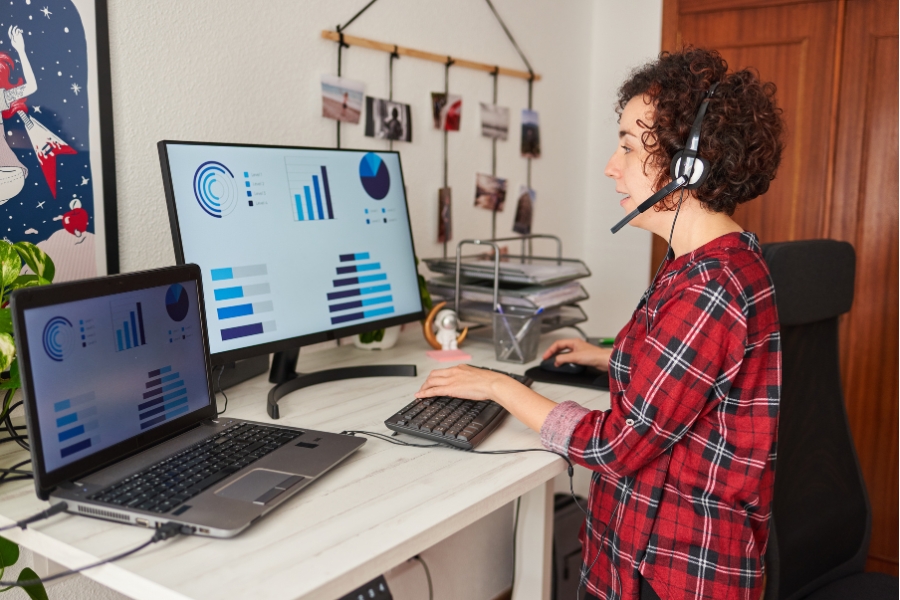
Benefits and importance of Adjusting your workstation to avoid back pain from sitting all day
Adjust your workstation: An ergonomically designed workstation is crucial for back health. I’ve taken the time to adjust my workspace to ensure that my body is properly aligned and supported while I work. This includes positioning my monitor at eye level, using a keyboard tray to keep my wrists straight, and keeping essential items within easy reach to avoid unnecessary strain.
My desk height is set so that my elbows are at a 90-degree angle when typing, which reduces stress on my shoulders and neck. I also use a footrest to keep my feet flat and my knees at the correct angle, which helps maintain the natural curve of my spine.
By making these adjustments, I’ve noticed a significant difference in my comfort level throughout the day. My back feels supported, and I’m less likely to slouch or hunch over, which can lead to pain and discomfort.
Benefits of Adjusting Your Workstation:
- Reduced Back Pain: By creating a workstation that encourages proper posture and alignment, you can significantly reduce strain on your back muscles and joints, preventing and alleviating back pain.
-
Improved Posture: An ergonomic workstation provides the necessary support to maintain a neutral spine, preventing slouching and hunching, which can lead to various postural problems.
-
Enhanced Comfort: A well-adjusted workstation can significantly increase your comfort level throughout the day, reducing fatigue and allowing you to focus on your work more effectively.
-
Increased Productivity: Studies have shown that a comfortable and ergonomic work environment can lead to increased productivity and improved focus.
-
Reduced Risk of Long-Term Health Problems: Sitting for long periods has been linked to various health problems, including obesity, heart disease, and diabetes. By encouraging movement and improving posture, an ergonomic workstation can help reduce your risk of developing these conditions.
Importance of Adjusting Your Workstation:
Our bodies are not designed to sit for long periods. Prolonged sitting puts undue stress on our muscles, joints, and spine, leading to various health problems. Adjusting your workstation is crucial for:
-
Preventing Back Pain and Other Musculoskeletal Disorders: By promoting proper posture and encouraging movement, an ergonomic workstation can help prevent back pain, neck pain, and other musculoskeletal disorders.
-
Maintaining Good Health: An ergonomic workstation can contribute to your overall health and well-being by reducing your risk of developing various health problems associated with prolonged sitting.
-
Improving Work Performance: A comfortable and healthy work environment can lead to increased productivity, focus, and creativity.
Incorporating simple adjustments to your workstation, such as using a chair with good lumbar support, adjusting your monitor height, and taking frequent breaks to move around, can significantly improve your comfort, health, and productivity.
Benefits and importance of Using a standing desk to avoid back pain from sitting all day
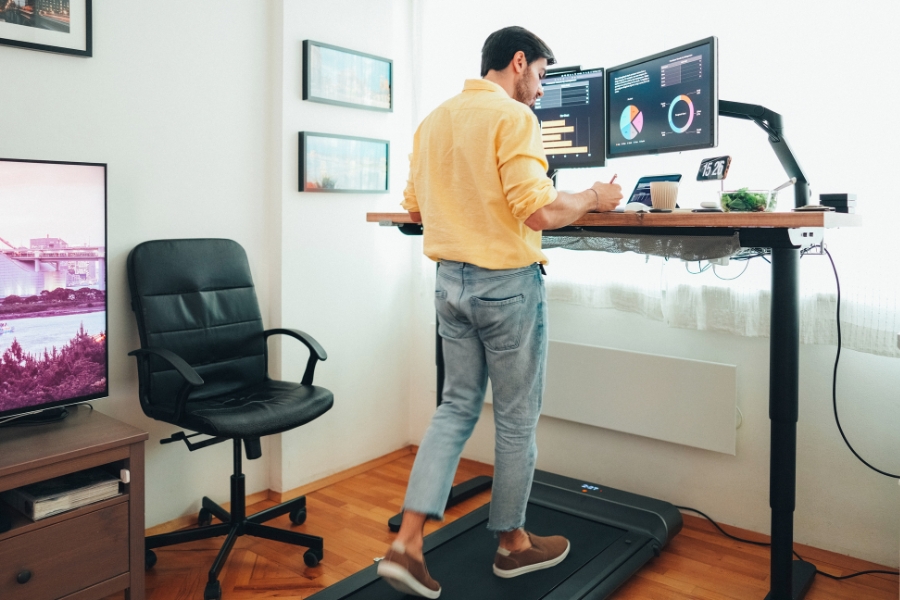
Benefits and importance of Using a standing desk to avoid back pain from sitting all day
Use a standing desk: A standing desk offers a great alternative to sitting all day and can provide numerous benefits for back health. I’ve incorporated a height-adjustable standing desk into my office, which allows me to alternate between sitting and standing throughout the day.
Standing while working engages different muscle groups and encourages me to maintain good posture. It also reduces the pressure on my lower back that comes from sitting in a chair for extended periods. I find that standing for part of the day helps me stay more alert and focused, and it also burns more calories than sitting.
When using a standing desk, it’s important to wear comfortable shoes and use an anti-fatigue mat to reduce the impact on the feet and legs. I also make sure to change my position frequently, shifting my weight from one foot to the other to avoid fatigue and to promote circulation.
Here are some of the benefits and importance of using a standing desk to avoid back pain from sitting all day:
- Reduced back pain: Studies have shown that using a standing desk can help reduce lower back pain. This is likely because standing takes pressure off the spine and discs, which can help to prevent pain and stiffness.
- Improved posture: Sitting for long periods can lead to poor posture, which can contribute to back pain. Standing desks can help to improve posture by encouraging you to stand tall and aligned.
- Increased blood flow: Standing increases blood flow throughout the body, which can help to improve circulation and reduce the risk of blood clots.
- Increased energy levels: Some studies have shown that using a standing desk can lead to increased energy levels and reduced fatigue.
- Increased productivity: There is some evidence that using a standing desk can lead to increased productivity. However, more research is needed to confirm this.
It is important to note that standing desks are not a cure for back pain. If you are experiencing back pain, it is important to see a doctor to determine the cause of your pain and get treatment.
Here are some additional tips for avoiding back pain:
- Take breaks from sitting every 30-60 minutes to get up and move around.
- Make sure your chair is properly adjusted and provides good support for your back.
- Practice good posture when sitting and standing.
- Strengthen your core muscles, which can help to support your spine.
Benefits and importance of Maintaining a healthy weight to avoid back pain from sitting all day

Benefits and importance of Maintaining a healthy weight to avoid back pain from sitting all day
Maintain a healthy weight: Excess weight can put additional strain on the back, particularly the lower back. Maintaining a healthy weight through a balanced diet and regular exercise can have a profound impact on back health. I’ve found that by keeping my weight in check, I’ve reduced the burden on my spine and lessened the likelihood of developing back pain.
A nutritious diet that includes plenty of fruits, vegetables, lean proteins, and whole grains helps me manage my weight and provides the energy I need to stay active. I also engage in regular cardiovascular and strength-training exercises, which help burn calories and build muscle to support my back.
In addition to the physical benefits, maintaining a healthy weight can also improve my overall sense of well-being. When I feel good physically, I’m more productive and less prone to the stress that can contribute to muscle tension and back pain.
Maintaining a healthy weight is important for many reasons, and one of them is to help prevent back pain, especially for those who sit all day. Here’s why:
-
Reduced stress on the spine: Every extra pound of body weight puts additional pressure on your spine, particularly the lower back. This can lead to strain, pain, and even disc problems over time.
-
Improved posture: Excess weight can pull your center of gravity forward, which can cause you to slouch and put further strain on your back muscles. Maintaining a healthy weight can help you maintain proper posture, which takes pressure off your spine and helps prevent pain.
-
Stronger core muscles: When you’re at a healthy weight, your core muscles are better able to support your spine and keep you balanced. This can help reduce your risk of developing back pain from sitting for long periods.
-
Increased flexibility: Maintaining a healthy weight can also improve your flexibility, which makes it easier to move around and change positions throughout the day. This can help prevent stiffness and pain in your back.
Here are some tips for maintaining a healthy weight:
- Eat a healthy diet that is low in processed foods, sugary drinks, and unhealthy fats.
- Aim for at least 30 minutes of moderate-intensity exercise most days of the week.
- Talk to your doctor about your weight loss goals and get their help in creating a safe and effective plan.
By maintaining a healthy weight, you can help reduce your risk of developing back pain from sitting all day and improve your overall health and well-being.
Benefits and importance of See a doctor if you have back pain to avoid back pain from sitting all day

Benefits and importance of See a doctor if you have back pain to avoid back pain from sitting all day
See a doctor if you have back pain: While many instances of back pain can be managed with the strategies I’ve outlined, there are times when it’s important to consult a medical professional. If I experience back pain that is severe, persistent, or accompanied by other symptoms like numbness or tingling, I know it’s time to see a doctor.
A healthcare provider can diagnose the cause of back pain and recommend appropriate treatment options. This might include physical therapy, medication, or in some cases, surgery. It’s crucial not to ignore back pain that doesn’t improve with self-care, as it could be a sign of a more serious condition.
I make it a point to listen to my body and seek medical advice when necessary. Timely intervention can prevent further damage and help me return to a pain-free state more quickly.
Benefits of seeing a doctor for back pain:
- Early diagnosis and treatment: A doctor can help identify the underlying cause of your back pain and recommend the best course of treatment. Early diagnosis and treatment can help prevent the pain from worsening and improve your overall quality of life.
- Pain relief: A doctor can prescribe medication or physical therapy to help relieve your pain and improve your function.
- Preventing future problems: A doctor can help you identify risk factors for future back pain and develop a plan to prevent it.
Importance of seeing a doctor:
- If your pain is severe or doesn’t improve with home care: If your pain is so severe that it’s interfering with your daily activities or you’ve tried home care methods for a week or two with no relief, it’s important to see a doctor.
- If you have any of the following symptoms along with your back pain:
- Fever
- Numbness or tingling in your legs or arms
- Weakness in your legs or arms
- Loss of bowel or bladder control
- If you have a history of certain medical conditions: If you have a history of cancer, osteoporosis, or other medical conditions that can cause back pain, it’s important to see a doctor to rule out these conditions.
By seeing a doctor for your back pain, you can get the treatment you need to feel better and prevent future problems.
Conclusion
Avoiding back pain when sitting all day requires a multifaceted approach, but it’s entirely possible with the right habits and tools. By maintaining good posture, getting up to move around regularly, using an ergonomic chair, stretching, strengthening core muscles, taking breaks, adjusting my workstation, using a standing desk, maintaining a healthy weight, and knowing when to seek medical help, I’ve managed to keep back pain at bay. It’s a journey that requires commitment and awareness, but the payoff is a healthier, more comfortable life, both at and away from my desk.
For anyone struggling with back pain or looking to prevent it, I encourage you to try implementing these strategies. Remember, taking care of your back is a long-term investment in your health and well-being. If you have any concerns or persistent pain, don’t hesitate to consult a healthcare professional for personalized guidance and support.














[…] for those of us with desk jobs. Unfortunately, this sedentary lifestyle can lead to or exacerbate chronic back pain. Ergonomic chairs are a vital investment in one’s health and productivity. They are […]